University Food Safety Project: Eat and Stay Safe Magazine Articles
VerifiedAdded on 2023/04/20
|29
|7037
|380
Project
AI Summary
This project comprises a series of magazine articles focused on food safety, designed to educate readers on critical aspects of food handling and consumption. The first article delves into foodborne illnesses, detailing preventive controls for chemical and physical contamination, and distinguishing between food poisoning and foodborne infections. It also explores outbreak examples and control measures like cleaning, separation, cooking, and storage. The second article examines food spoilage agents, categorizing bacteria, molds, and yeasts, and then discusses various preservation methods such as drying, freezing, pasteurization, canning, and the use of preservatives. The final article addresses effective prevention systems within the food industry, focusing on temperature control, food storage safety, cleaning and disinfection, pest control, hygiene design, and the importance of training. The articles collectively aim to provide a comprehensive understanding of food safety practices, from individual actions to industry-wide standards, emphasizing the importance of safe food handling to prevent illness and promote public health.
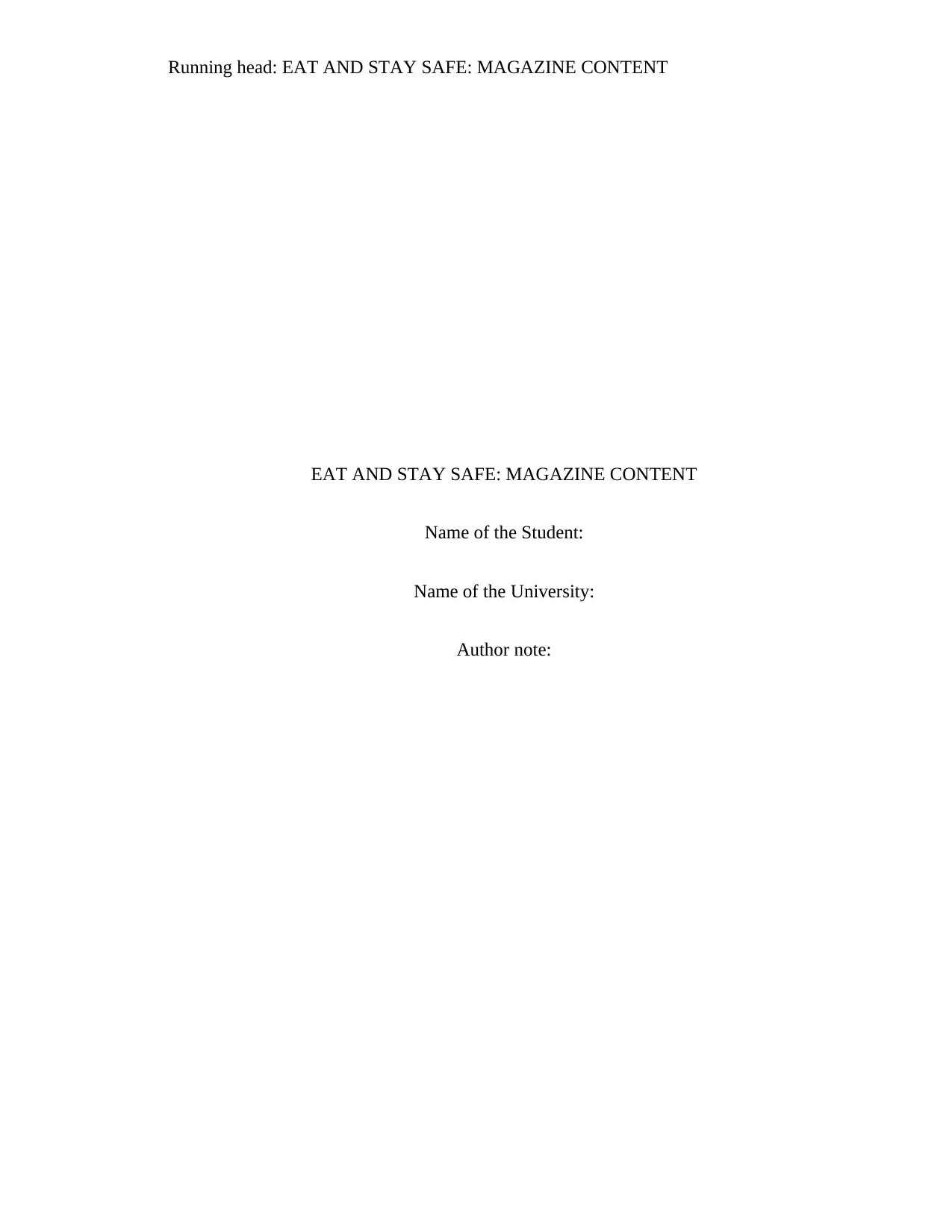
Running head: EAT AND STAY SAFE: MAGAZINE CONTENT
EAT AND STAY SAFE: MAGAZINE CONTENT
Name of the Student:
Name of the University:
Author note:
EAT AND STAY SAFE: MAGAZINE CONTENT
Name of the Student:
Name of the University:
Author note:
Paraphrase This Document
Need a fresh take? Get an instant paraphrase of this document with our AI Paraphraser
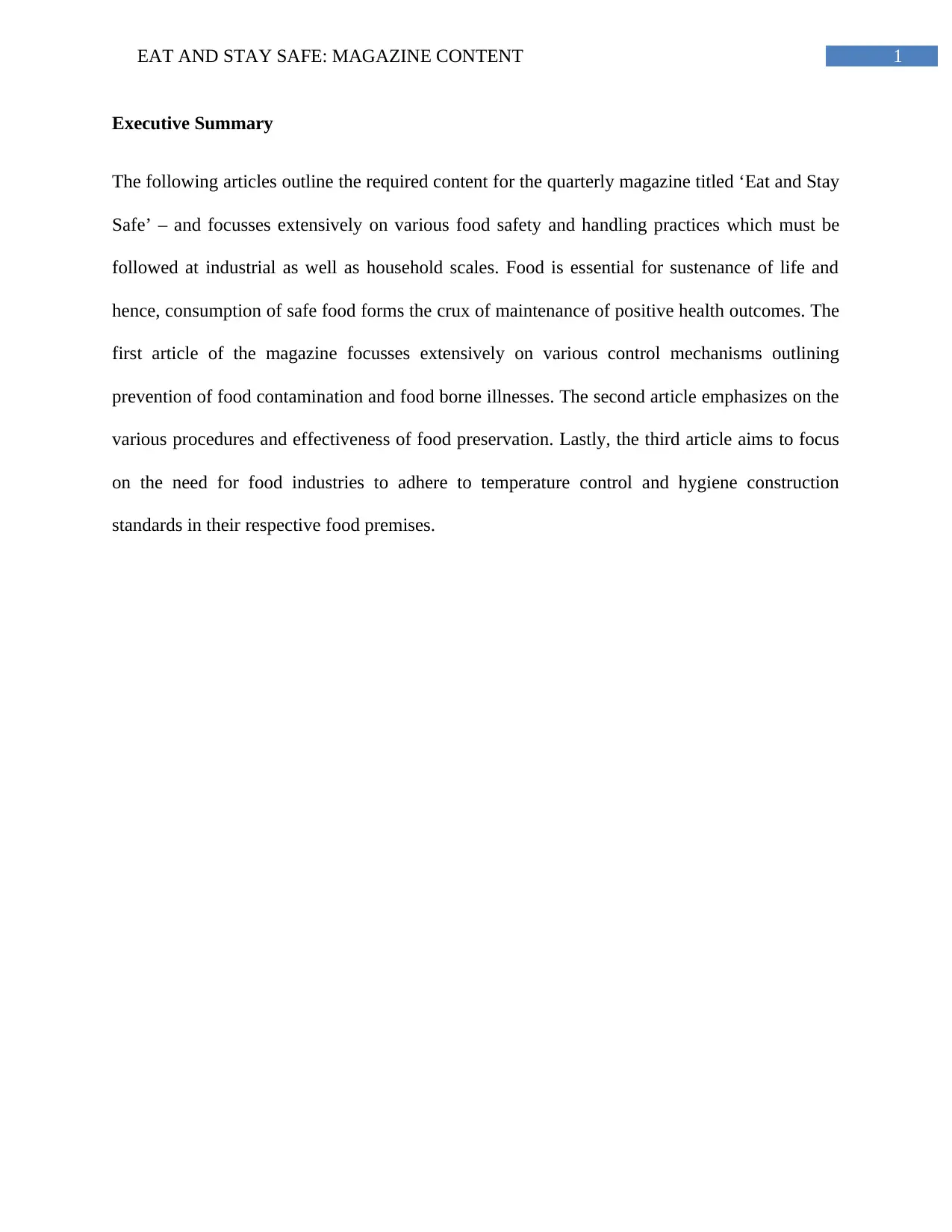
1EAT AND STAY SAFE: MAGAZINE CONTENT
Executive Summary
The following articles outline the required content for the quarterly magazine titled ‘Eat and Stay
Safe’ – and focusses extensively on various food safety and handling practices which must be
followed at industrial as well as household scales. Food is essential for sustenance of life and
hence, consumption of safe food forms the crux of maintenance of positive health outcomes. The
first article of the magazine focusses extensively on various control mechanisms outlining
prevention of food contamination and food borne illnesses. The second article emphasizes on the
various procedures and effectiveness of food preservation. Lastly, the third article aims to focus
on the need for food industries to adhere to temperature control and hygiene construction
standards in their respective food premises.
Executive Summary
The following articles outline the required content for the quarterly magazine titled ‘Eat and Stay
Safe’ – and focusses extensively on various food safety and handling practices which must be
followed at industrial as well as household scales. Food is essential for sustenance of life and
hence, consumption of safe food forms the crux of maintenance of positive health outcomes. The
first article of the magazine focusses extensively on various control mechanisms outlining
prevention of food contamination and food borne illnesses. The second article emphasizes on the
various procedures and effectiveness of food preservation. Lastly, the third article aims to focus
on the need for food industries to adhere to temperature control and hygiene construction
standards in their respective food premises.
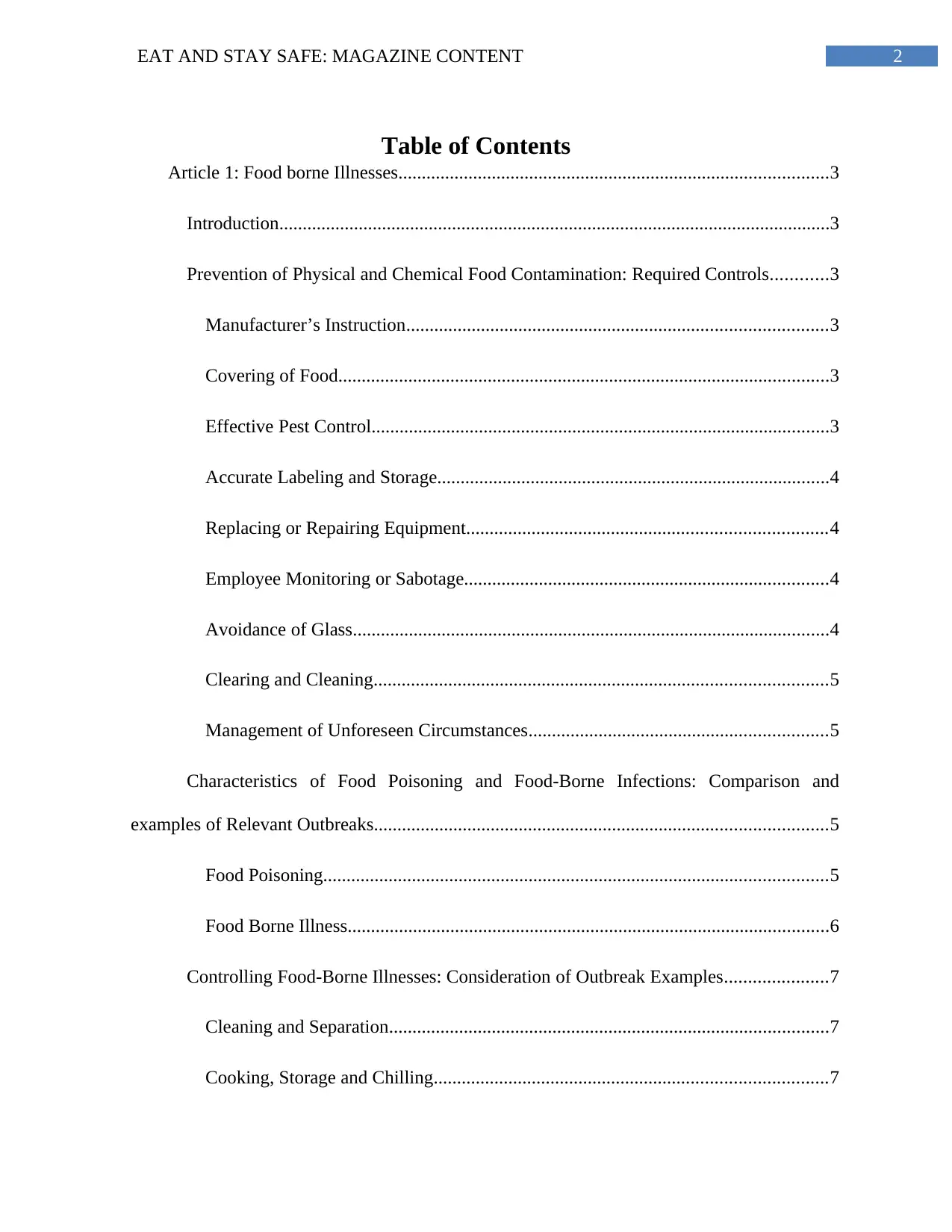
2EAT AND STAY SAFE: MAGAZINE CONTENT
Table of Contents
Article 1: Food borne Illnesses............................................................................................3
Introduction......................................................................................................................3
Prevention of Physical and Chemical Food Contamination: Required Controls............3
Manufacturer’s Instruction..........................................................................................3
Covering of Food.........................................................................................................3
Effective Pest Control..................................................................................................3
Accurate Labeling and Storage....................................................................................4
Replacing or Repairing Equipment.............................................................................4
Employee Monitoring or Sabotage..............................................................................4
Avoidance of Glass......................................................................................................4
Clearing and Cleaning.................................................................................................5
Management of Unforeseen Circumstances................................................................5
Characteristics of Food Poisoning and Food-Borne Infections: Comparison and
examples of Relevant Outbreaks.................................................................................................5
Food Poisoning............................................................................................................5
Food Borne Illness.......................................................................................................6
Controlling Food-Borne Illnesses: Consideration of Outbreak Examples......................7
Cleaning and Separation..............................................................................................7
Cooking, Storage and Chilling....................................................................................7
Table of Contents
Article 1: Food borne Illnesses............................................................................................3
Introduction......................................................................................................................3
Prevention of Physical and Chemical Food Contamination: Required Controls............3
Manufacturer’s Instruction..........................................................................................3
Covering of Food.........................................................................................................3
Effective Pest Control..................................................................................................3
Accurate Labeling and Storage....................................................................................4
Replacing or Repairing Equipment.............................................................................4
Employee Monitoring or Sabotage..............................................................................4
Avoidance of Glass......................................................................................................4
Clearing and Cleaning.................................................................................................5
Management of Unforeseen Circumstances................................................................5
Characteristics of Food Poisoning and Food-Borne Infections: Comparison and
examples of Relevant Outbreaks.................................................................................................5
Food Poisoning............................................................................................................5
Food Borne Illness.......................................................................................................6
Controlling Food-Borne Illnesses: Consideration of Outbreak Examples......................7
Cleaning and Separation..............................................................................................7
Cooking, Storage and Chilling....................................................................................7
⊘ This is a preview!⊘
Do you want full access?
Subscribe today to unlock all pages.

Trusted by 1+ million students worldwide
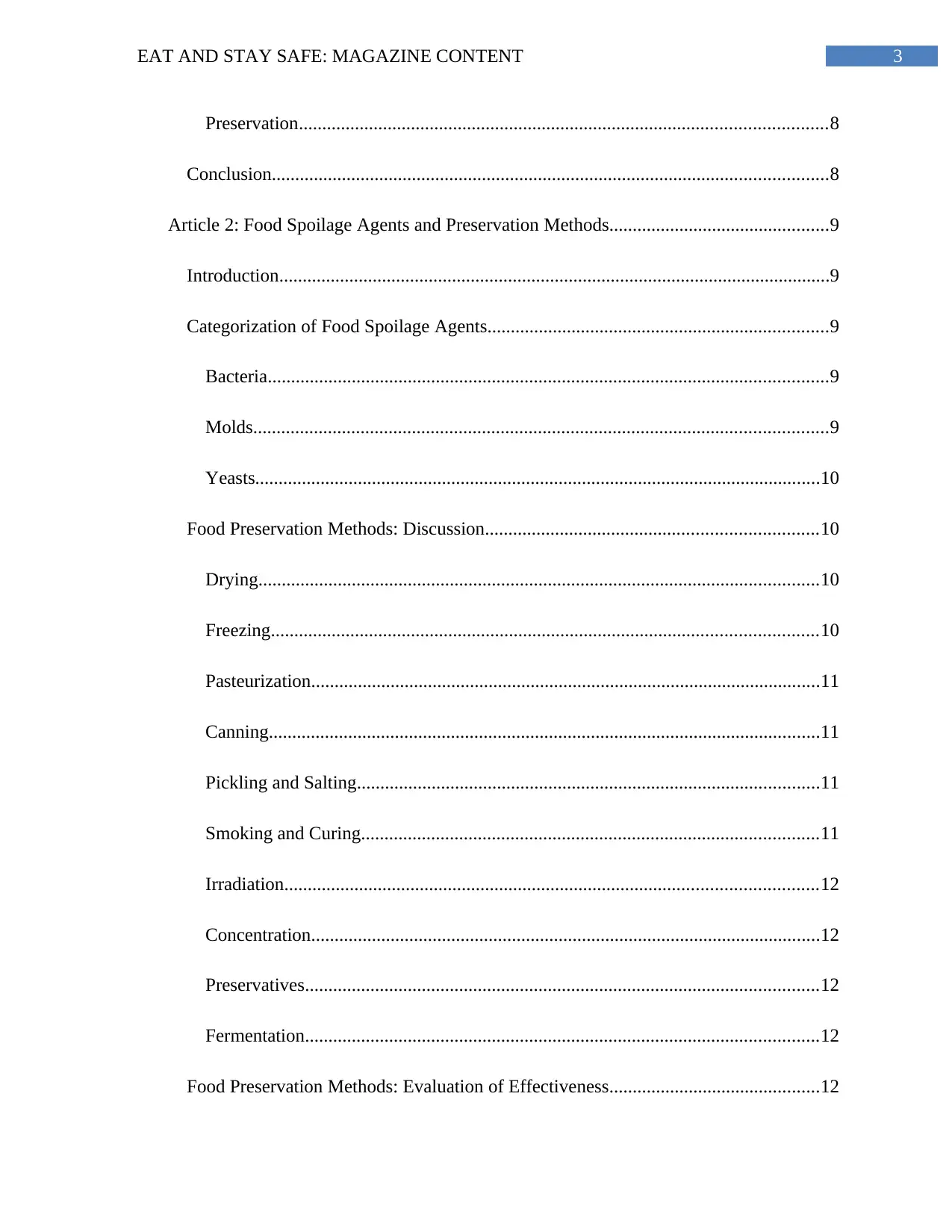
3EAT AND STAY SAFE: MAGAZINE CONTENT
Preservation.................................................................................................................8
Conclusion.......................................................................................................................8
Article 2: Food Spoilage Agents and Preservation Methods...............................................9
Introduction......................................................................................................................9
Categorization of Food Spoilage Agents.........................................................................9
Bacteria........................................................................................................................9
Molds...........................................................................................................................9
Yeasts.........................................................................................................................10
Food Preservation Methods: Discussion.......................................................................10
Drying........................................................................................................................10
Freezing.....................................................................................................................10
Pasteurization.............................................................................................................11
Canning......................................................................................................................11
Pickling and Salting...................................................................................................11
Smoking and Curing..................................................................................................11
Irradiation..................................................................................................................12
Concentration.............................................................................................................12
Preservatives..............................................................................................................12
Fermentation..............................................................................................................12
Food Preservation Methods: Evaluation of Effectiveness.............................................12
Preservation.................................................................................................................8
Conclusion.......................................................................................................................8
Article 2: Food Spoilage Agents and Preservation Methods...............................................9
Introduction......................................................................................................................9
Categorization of Food Spoilage Agents.........................................................................9
Bacteria........................................................................................................................9
Molds...........................................................................................................................9
Yeasts.........................................................................................................................10
Food Preservation Methods: Discussion.......................................................................10
Drying........................................................................................................................10
Freezing.....................................................................................................................10
Pasteurization.............................................................................................................11
Canning......................................................................................................................11
Pickling and Salting...................................................................................................11
Smoking and Curing..................................................................................................11
Irradiation..................................................................................................................12
Concentration.............................................................................................................12
Preservatives..............................................................................................................12
Fermentation..............................................................................................................12
Food Preservation Methods: Evaluation of Effectiveness.............................................12
Paraphrase This Document
Need a fresh take? Get an instant paraphrase of this document with our AI Paraphraser
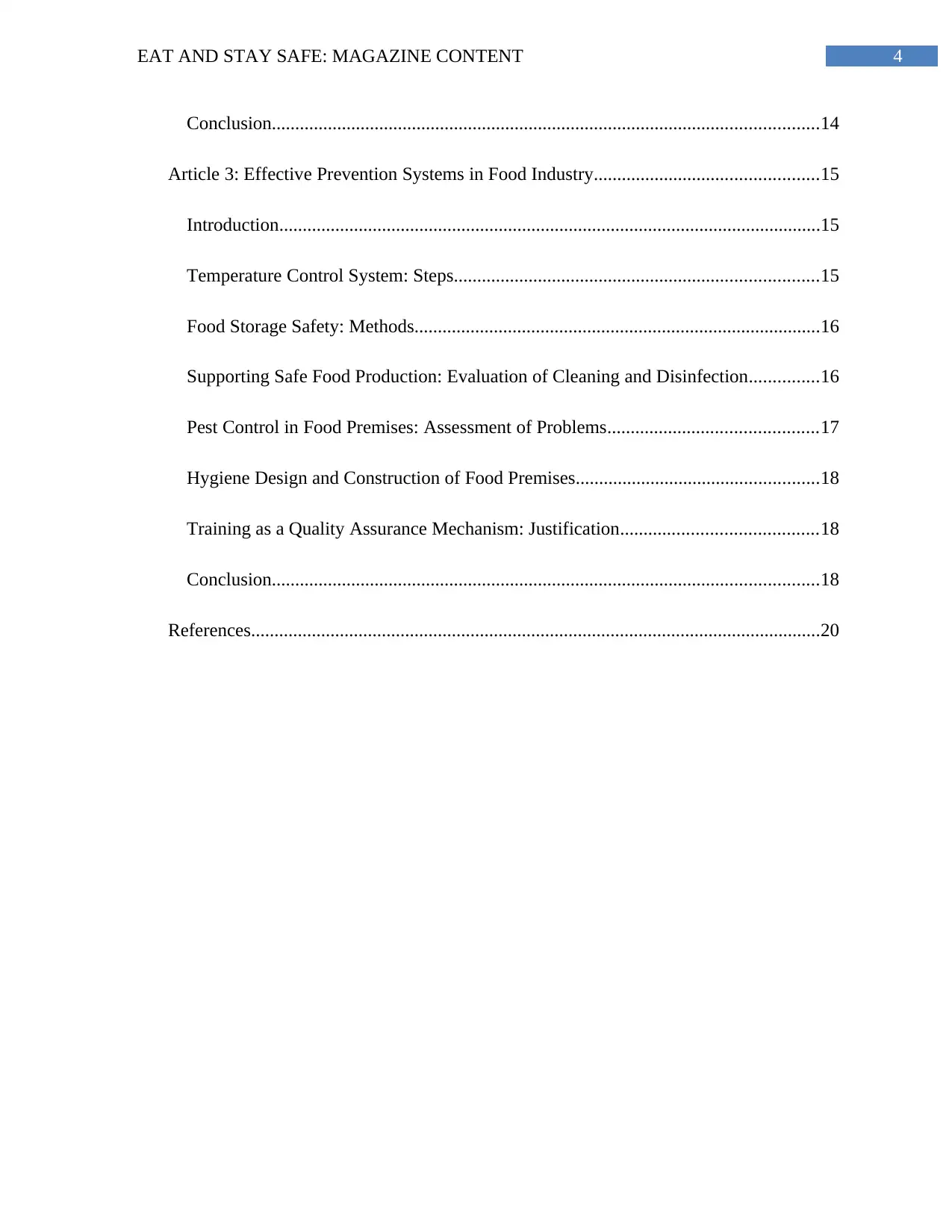
4EAT AND STAY SAFE: MAGAZINE CONTENT
Conclusion.....................................................................................................................14
Article 3: Effective Prevention Systems in Food Industry................................................15
Introduction....................................................................................................................15
Temperature Control System: Steps..............................................................................15
Food Storage Safety: Methods.......................................................................................16
Supporting Safe Food Production: Evaluation of Cleaning and Disinfection...............16
Pest Control in Food Premises: Assessment of Problems.............................................17
Hygiene Design and Construction of Food Premises....................................................18
Training as a Quality Assurance Mechanism: Justification..........................................18
Conclusion.....................................................................................................................18
References..........................................................................................................................20
Conclusion.....................................................................................................................14
Article 3: Effective Prevention Systems in Food Industry................................................15
Introduction....................................................................................................................15
Temperature Control System: Steps..............................................................................15
Food Storage Safety: Methods.......................................................................................16
Supporting Safe Food Production: Evaluation of Cleaning and Disinfection...............16
Pest Control in Food Premises: Assessment of Problems.............................................17
Hygiene Design and Construction of Food Premises....................................................18
Training as a Quality Assurance Mechanism: Justification..........................................18
Conclusion.....................................................................................................................18
References..........................................................................................................................20
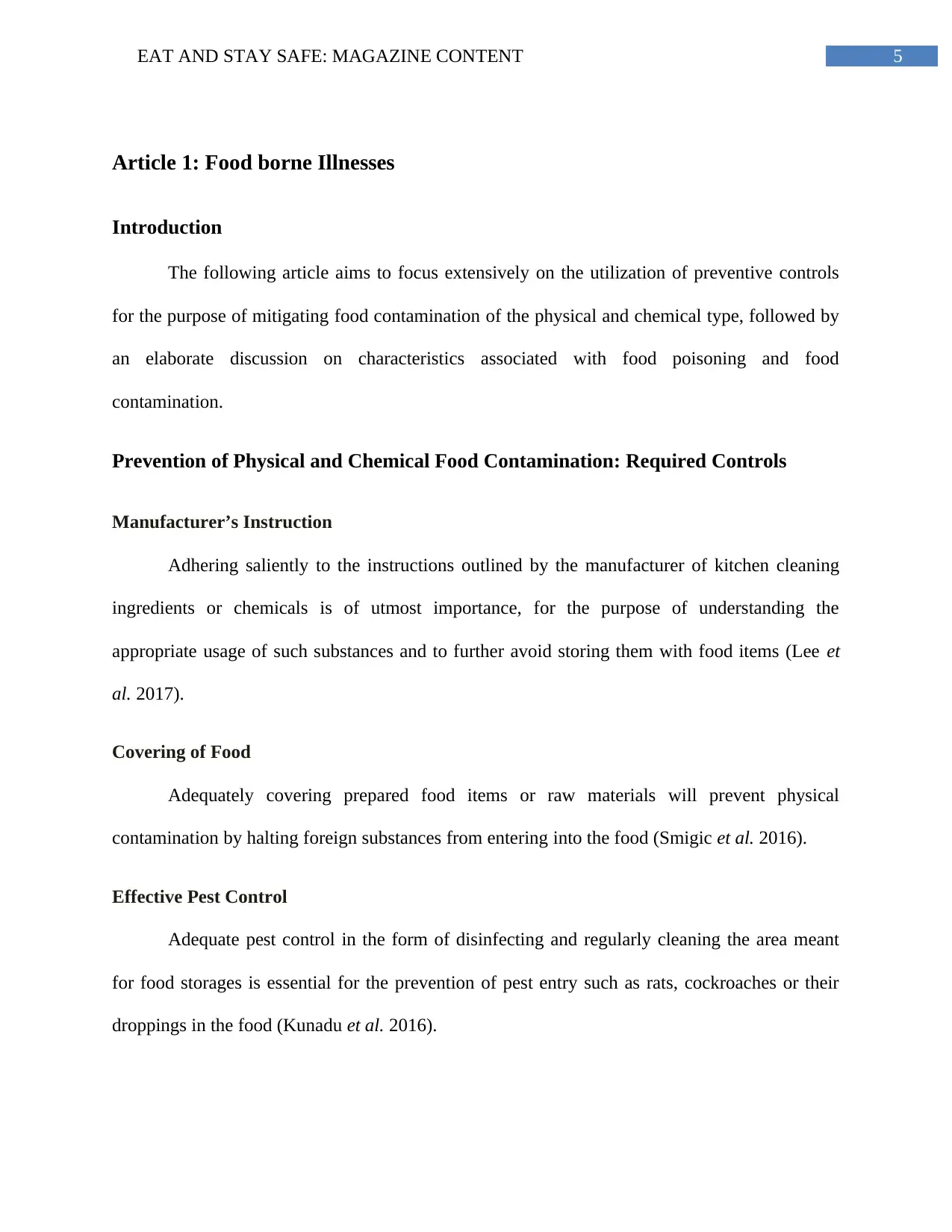
5EAT AND STAY SAFE: MAGAZINE CONTENT
Article 1: Food borne Illnesses
Introduction
The following article aims to focus extensively on the utilization of preventive controls
for the purpose of mitigating food contamination of the physical and chemical type, followed by
an elaborate discussion on characteristics associated with food poisoning and food
contamination.
Prevention of Physical and Chemical Food Contamination: Required Controls
Manufacturer’s Instruction
Adhering saliently to the instructions outlined by the manufacturer of kitchen cleaning
ingredients or chemicals is of utmost importance, for the purpose of understanding the
appropriate usage of such substances and to further avoid storing them with food items (Lee et
al. 2017).
Covering of Food
Adequately covering prepared food items or raw materials will prevent physical
contamination by halting foreign substances from entering into the food (Smigic et al. 2016).
Effective Pest Control
Adequate pest control in the form of disinfecting and regularly cleaning the area meant
for food storages is essential for the prevention of pest entry such as rats, cockroaches or their
droppings in the food (Kunadu et al. 2016).
Article 1: Food borne Illnesses
Introduction
The following article aims to focus extensively on the utilization of preventive controls
for the purpose of mitigating food contamination of the physical and chemical type, followed by
an elaborate discussion on characteristics associated with food poisoning and food
contamination.
Prevention of Physical and Chemical Food Contamination: Required Controls
Manufacturer’s Instruction
Adhering saliently to the instructions outlined by the manufacturer of kitchen cleaning
ingredients or chemicals is of utmost importance, for the purpose of understanding the
appropriate usage of such substances and to further avoid storing them with food items (Lee et
al. 2017).
Covering of Food
Adequately covering prepared food items or raw materials will prevent physical
contamination by halting foreign substances from entering into the food (Smigic et al. 2016).
Effective Pest Control
Adequate pest control in the form of disinfecting and regularly cleaning the area meant
for food storages is essential for the prevention of pest entry such as rats, cockroaches or their
droppings in the food (Kunadu et al. 2016).
⊘ This is a preview!⊘
Do you want full access?
Subscribe today to unlock all pages.

Trusted by 1+ million students worldwide
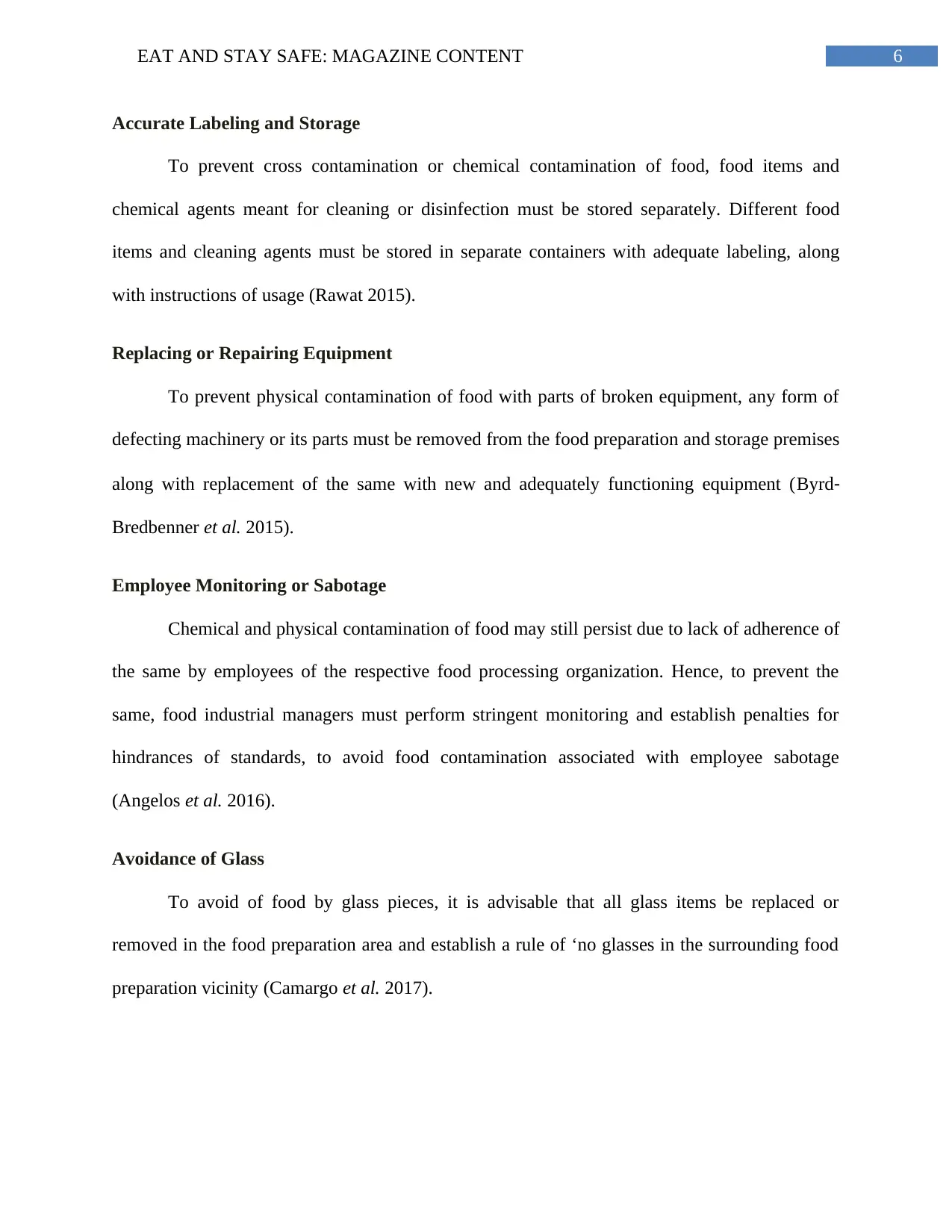
6EAT AND STAY SAFE: MAGAZINE CONTENT
Accurate Labeling and Storage
To prevent cross contamination or chemical contamination of food, food items and
chemical agents meant for cleaning or disinfection must be stored separately. Different food
items and cleaning agents must be stored in separate containers with adequate labeling, along
with instructions of usage (Rawat 2015).
Replacing or Repairing Equipment
To prevent physical contamination of food with parts of broken equipment, any form of
defecting machinery or its parts must be removed from the food preparation and storage premises
along with replacement of the same with new and adequately functioning equipment (Byrd‐
Bredbenner et al. 2015).
Employee Monitoring or Sabotage
Chemical and physical contamination of food may still persist due to lack of adherence of
the same by employees of the respective food processing organization. Hence, to prevent the
same, food industrial managers must perform stringent monitoring and establish penalties for
hindrances of standards, to avoid food contamination associated with employee sabotage
(Angelos et al. 2016).
Avoidance of Glass
To avoid of food by glass pieces, it is advisable that all glass items be replaced or
removed in the food preparation area and establish a rule of ‘no glasses in the surrounding food
preparation vicinity (Camargo et al. 2017).
Accurate Labeling and Storage
To prevent cross contamination or chemical contamination of food, food items and
chemical agents meant for cleaning or disinfection must be stored separately. Different food
items and cleaning agents must be stored in separate containers with adequate labeling, along
with instructions of usage (Rawat 2015).
Replacing or Repairing Equipment
To prevent physical contamination of food with parts of broken equipment, any form of
defecting machinery or its parts must be removed from the food preparation and storage premises
along with replacement of the same with new and adequately functioning equipment (Byrd‐
Bredbenner et al. 2015).
Employee Monitoring or Sabotage
Chemical and physical contamination of food may still persist due to lack of adherence of
the same by employees of the respective food processing organization. Hence, to prevent the
same, food industrial managers must perform stringent monitoring and establish penalties for
hindrances of standards, to avoid food contamination associated with employee sabotage
(Angelos et al. 2016).
Avoidance of Glass
To avoid of food by glass pieces, it is advisable that all glass items be replaced or
removed in the food preparation area and establish a rule of ‘no glasses in the surrounding food
preparation vicinity (Camargo et al. 2017).
Paraphrase This Document
Need a fresh take? Get an instant paraphrase of this document with our AI Paraphraser
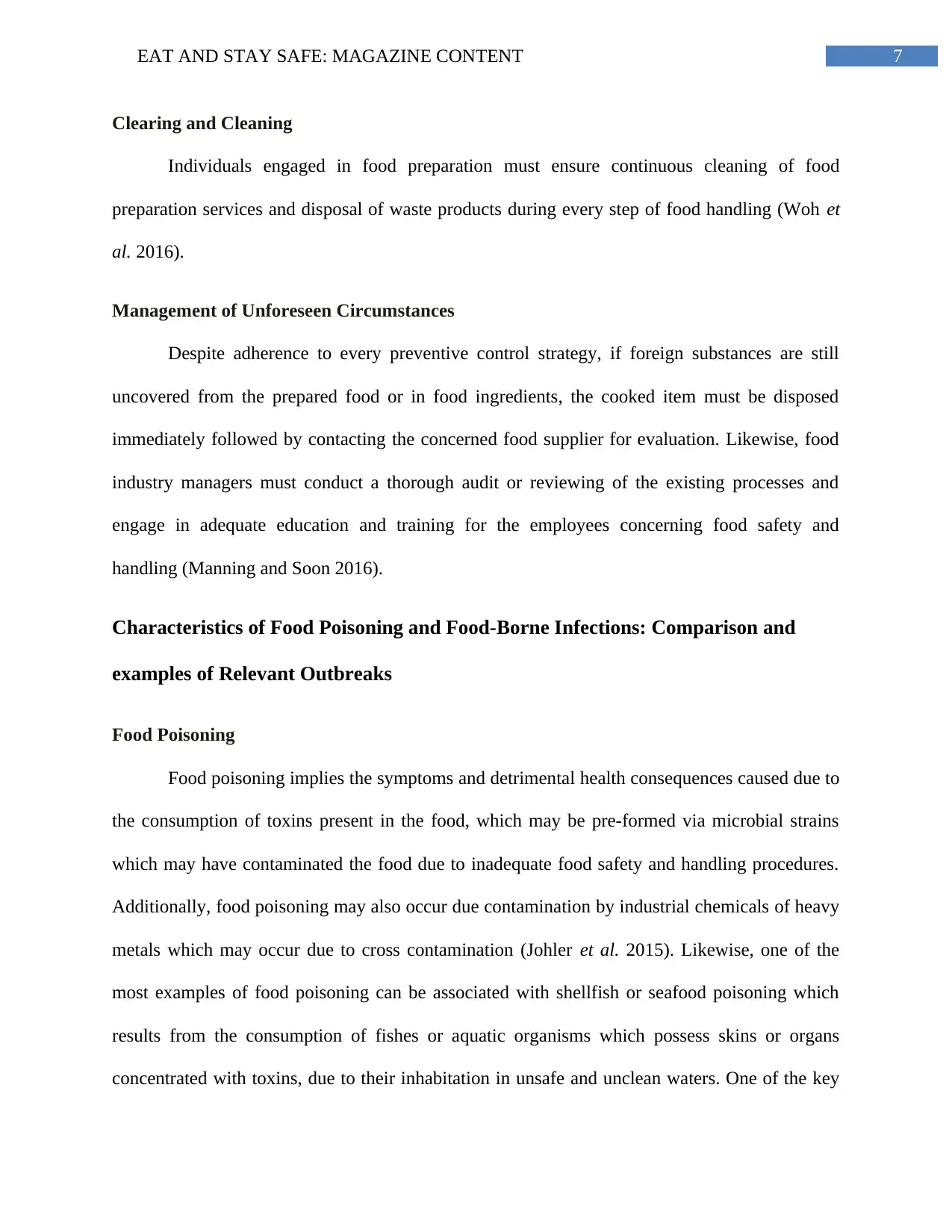
7EAT AND STAY SAFE: MAGAZINE CONTENT
Clearing and Cleaning
Individuals engaged in food preparation must ensure continuous cleaning of food
preparation services and disposal of waste products during every step of food handling (Woh et
al. 2016).
Management of Unforeseen Circumstances
Despite adherence to every preventive control strategy, if foreign substances are still
uncovered from the prepared food or in food ingredients, the cooked item must be disposed
immediately followed by contacting the concerned food supplier for evaluation. Likewise, food
industry managers must conduct a thorough audit or reviewing of the existing processes and
engage in adequate education and training for the employees concerning food safety and
handling (Manning and Soon 2016).
Characteristics of Food Poisoning and Food-Borne Infections: Comparison and
examples of Relevant Outbreaks
Food Poisoning
Food poisoning implies the symptoms and detrimental health consequences caused due to
the consumption of toxins present in the food, which may be pre-formed via microbial strains
which may have contaminated the food due to inadequate food safety and handling procedures.
Additionally, food poisoning may also occur due contamination by industrial chemicals of heavy
metals which may occur due to cross contamination (Johler et al. 2015). Likewise, one of the
most examples of food poisoning can be associated with shellfish or seafood poisoning which
results from the consumption of fishes or aquatic organisms which possess skins or organs
concentrated with toxins, due to their inhabitation in unsafe and unclean waters. One of the key
Clearing and Cleaning
Individuals engaged in food preparation must ensure continuous cleaning of food
preparation services and disposal of waste products during every step of food handling (Woh et
al. 2016).
Management of Unforeseen Circumstances
Despite adherence to every preventive control strategy, if foreign substances are still
uncovered from the prepared food or in food ingredients, the cooked item must be disposed
immediately followed by contacting the concerned food supplier for evaluation. Likewise, food
industry managers must conduct a thorough audit or reviewing of the existing processes and
engage in adequate education and training for the employees concerning food safety and
handling (Manning and Soon 2016).
Characteristics of Food Poisoning and Food-Borne Infections: Comparison and
examples of Relevant Outbreaks
Food Poisoning
Food poisoning implies the symptoms and detrimental health consequences caused due to
the consumption of toxins present in the food, which may be pre-formed via microbial strains
which may have contaminated the food due to inadequate food safety and handling procedures.
Additionally, food poisoning may also occur due contamination by industrial chemicals of heavy
metals which may occur due to cross contamination (Johler et al. 2015). Likewise, one of the
most examples of food poisoning can be associated with shellfish or seafood poisoning which
results from the consumption of fishes or aquatic organisms which possess skins or organs
concentrated with toxins, due to their inhabitation in unsafe and unclean waters. One of the key
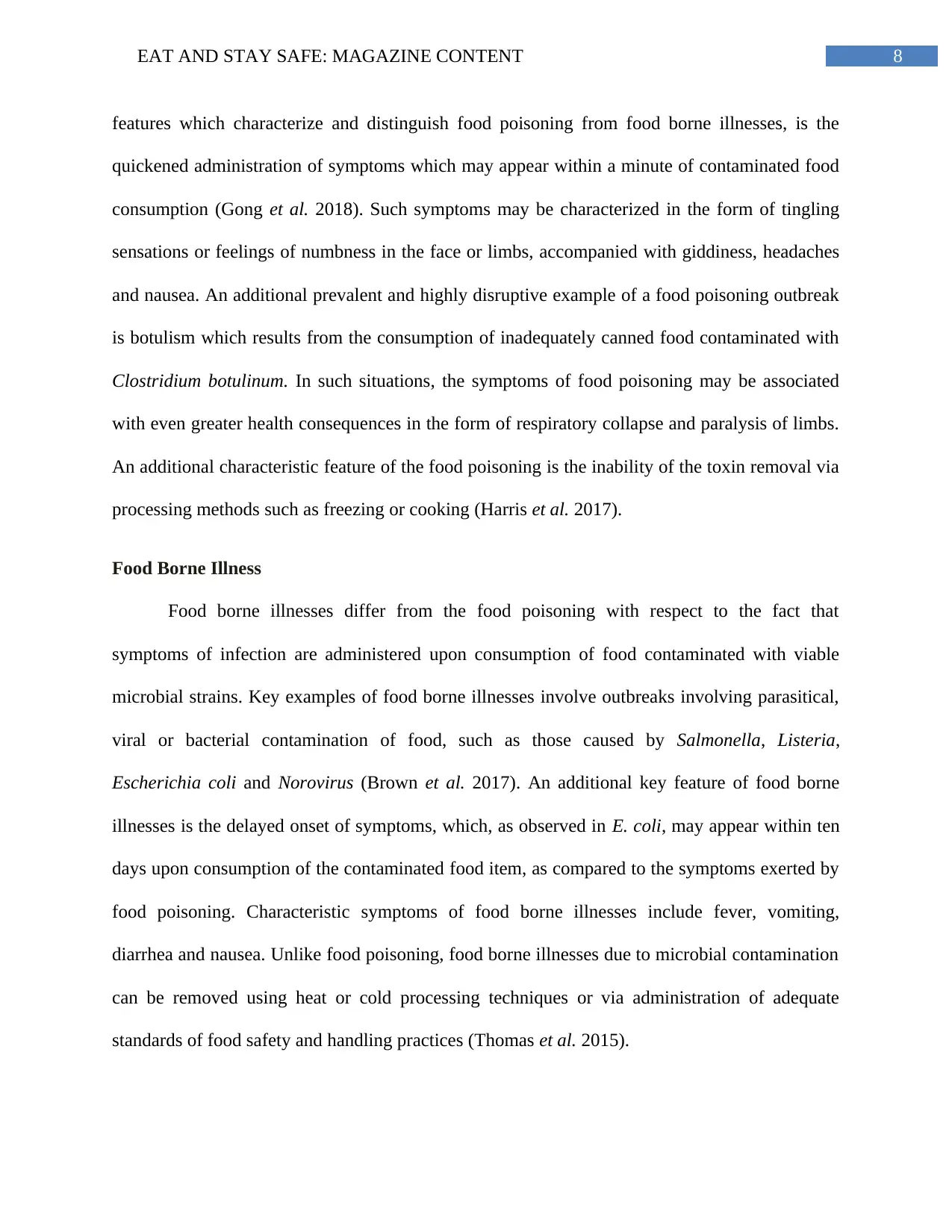
8EAT AND STAY SAFE: MAGAZINE CONTENT
features which characterize and distinguish food poisoning from food borne illnesses, is the
quickened administration of symptoms which may appear within a minute of contaminated food
consumption (Gong et al. 2018). Such symptoms may be characterized in the form of tingling
sensations or feelings of numbness in the face or limbs, accompanied with giddiness, headaches
and nausea. An additional prevalent and highly disruptive example of a food poisoning outbreak
is botulism which results from the consumption of inadequately canned food contaminated with
Clostridium botulinum. In such situations, the symptoms of food poisoning may be associated
with even greater health consequences in the form of respiratory collapse and paralysis of limbs.
An additional characteristic feature of the food poisoning is the inability of the toxin removal via
processing methods such as freezing or cooking (Harris et al. 2017).
Food Borne Illness
Food borne illnesses differ from the food poisoning with respect to the fact that
symptoms of infection are administered upon consumption of food contaminated with viable
microbial strains. Key examples of food borne illnesses involve outbreaks involving parasitical,
viral or bacterial contamination of food, such as those caused by Salmonella, Listeria,
Escherichia coli and Norovirus (Brown et al. 2017). An additional key feature of food borne
illnesses is the delayed onset of symptoms, which, as observed in E. coli, may appear within ten
days upon consumption of the contaminated food item, as compared to the symptoms exerted by
food poisoning. Characteristic symptoms of food borne illnesses include fever, vomiting,
diarrhea and nausea. Unlike food poisoning, food borne illnesses due to microbial contamination
can be removed using heat or cold processing techniques or via administration of adequate
standards of food safety and handling practices (Thomas et al. 2015).
features which characterize and distinguish food poisoning from food borne illnesses, is the
quickened administration of symptoms which may appear within a minute of contaminated food
consumption (Gong et al. 2018). Such symptoms may be characterized in the form of tingling
sensations or feelings of numbness in the face or limbs, accompanied with giddiness, headaches
and nausea. An additional prevalent and highly disruptive example of a food poisoning outbreak
is botulism which results from the consumption of inadequately canned food contaminated with
Clostridium botulinum. In such situations, the symptoms of food poisoning may be associated
with even greater health consequences in the form of respiratory collapse and paralysis of limbs.
An additional characteristic feature of the food poisoning is the inability of the toxin removal via
processing methods such as freezing or cooking (Harris et al. 2017).
Food Borne Illness
Food borne illnesses differ from the food poisoning with respect to the fact that
symptoms of infection are administered upon consumption of food contaminated with viable
microbial strains. Key examples of food borne illnesses involve outbreaks involving parasitical,
viral or bacterial contamination of food, such as those caused by Salmonella, Listeria,
Escherichia coli and Norovirus (Brown et al. 2017). An additional key feature of food borne
illnesses is the delayed onset of symptoms, which, as observed in E. coli, may appear within ten
days upon consumption of the contaminated food item, as compared to the symptoms exerted by
food poisoning. Characteristic symptoms of food borne illnesses include fever, vomiting,
diarrhea and nausea. Unlike food poisoning, food borne illnesses due to microbial contamination
can be removed using heat or cold processing techniques or via administration of adequate
standards of food safety and handling practices (Thomas et al. 2015).
⊘ This is a preview!⊘
Do you want full access?
Subscribe today to unlock all pages.

Trusted by 1+ million students worldwide
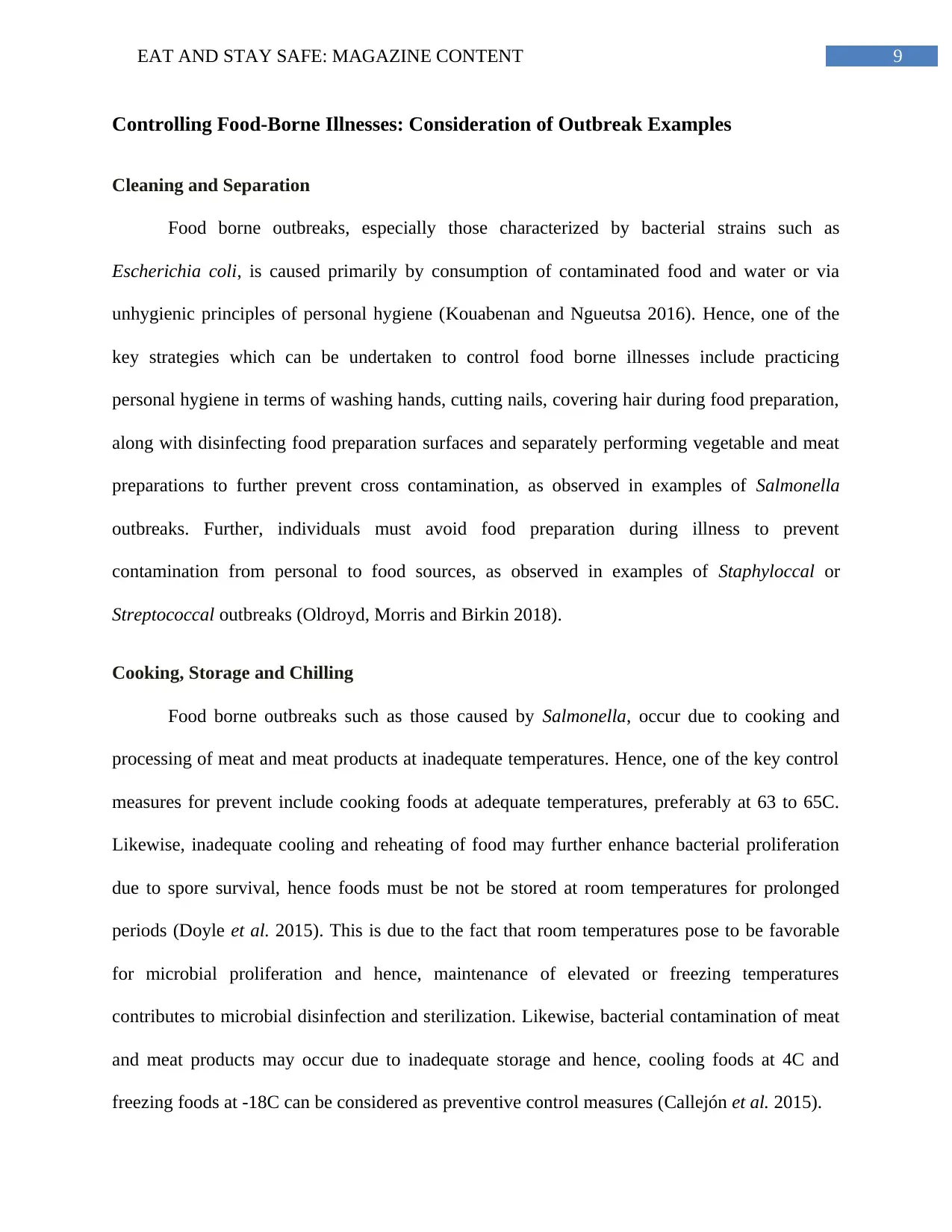
9EAT AND STAY SAFE: MAGAZINE CONTENT
Controlling Food-Borne Illnesses: Consideration of Outbreak Examples
Cleaning and Separation
Food borne outbreaks, especially those characterized by bacterial strains such as
Escherichia coli, is caused primarily by consumption of contaminated food and water or via
unhygienic principles of personal hygiene (Kouabenan and Ngueutsa 2016). Hence, one of the
key strategies which can be undertaken to control food borne illnesses include practicing
personal hygiene in terms of washing hands, cutting nails, covering hair during food preparation,
along with disinfecting food preparation surfaces and separately performing vegetable and meat
preparations to further prevent cross contamination, as observed in examples of Salmonella
outbreaks. Further, individuals must avoid food preparation during illness to prevent
contamination from personal to food sources, as observed in examples of Staphyloccal or
Streptococcal outbreaks (Oldroyd, Morris and Birkin 2018).
Cooking, Storage and Chilling
Food borne outbreaks such as those caused by Salmonella, occur due to cooking and
processing of meat and meat products at inadequate temperatures. Hence, one of the key control
measures for prevent include cooking foods at adequate temperatures, preferably at 63 to 65C.
Likewise, inadequate cooling and reheating of food may further enhance bacterial proliferation
due to spore survival, hence foods must be not be stored at room temperatures for prolonged
periods (Doyle et al. 2015). This is due to the fact that room temperatures pose to be favorable
for microbial proliferation and hence, maintenance of elevated or freezing temperatures
contributes to microbial disinfection and sterilization. Likewise, bacterial contamination of meat
and meat products may occur due to inadequate storage and hence, cooling foods at 4C and
freezing foods at -18C can be considered as preventive control measures (Callejón et al. 2015).
Controlling Food-Borne Illnesses: Consideration of Outbreak Examples
Cleaning and Separation
Food borne outbreaks, especially those characterized by bacterial strains such as
Escherichia coli, is caused primarily by consumption of contaminated food and water or via
unhygienic principles of personal hygiene (Kouabenan and Ngueutsa 2016). Hence, one of the
key strategies which can be undertaken to control food borne illnesses include practicing
personal hygiene in terms of washing hands, cutting nails, covering hair during food preparation,
along with disinfecting food preparation surfaces and separately performing vegetable and meat
preparations to further prevent cross contamination, as observed in examples of Salmonella
outbreaks. Further, individuals must avoid food preparation during illness to prevent
contamination from personal to food sources, as observed in examples of Staphyloccal or
Streptococcal outbreaks (Oldroyd, Morris and Birkin 2018).
Cooking, Storage and Chilling
Food borne outbreaks such as those caused by Salmonella, occur due to cooking and
processing of meat and meat products at inadequate temperatures. Hence, one of the key control
measures for prevent include cooking foods at adequate temperatures, preferably at 63 to 65C.
Likewise, inadequate cooling and reheating of food may further enhance bacterial proliferation
due to spore survival, hence foods must be not be stored at room temperatures for prolonged
periods (Doyle et al. 2015). This is due to the fact that room temperatures pose to be favorable
for microbial proliferation and hence, maintenance of elevated or freezing temperatures
contributes to microbial disinfection and sterilization. Likewise, bacterial contamination of meat
and meat products may occur due to inadequate storage and hence, cooling foods at 4C and
freezing foods at -18C can be considered as preventive control measures (Callejón et al. 2015).
Paraphrase This Document
Need a fresh take? Get an instant paraphrase of this document with our AI Paraphraser
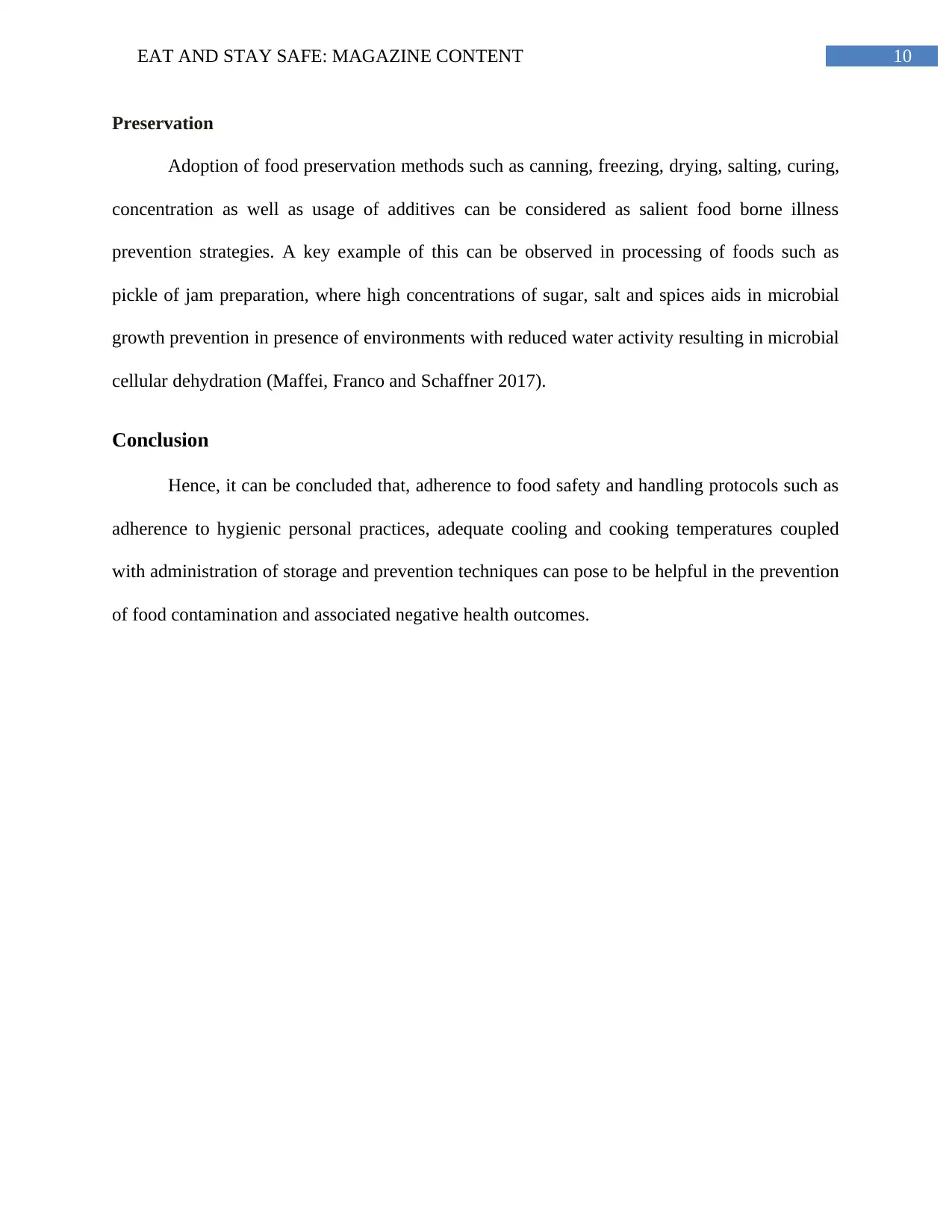
10EAT AND STAY SAFE: MAGAZINE CONTENT
Preservation
Adoption of food preservation methods such as canning, freezing, drying, salting, curing,
concentration as well as usage of additives can be considered as salient food borne illness
prevention strategies. A key example of this can be observed in processing of foods such as
pickle of jam preparation, where high concentrations of sugar, salt and spices aids in microbial
growth prevention in presence of environments with reduced water activity resulting in microbial
cellular dehydration (Maffei, Franco and Schaffner 2017).
Conclusion
Hence, it can be concluded that, adherence to food safety and handling protocols such as
adherence to hygienic personal practices, adequate cooling and cooking temperatures coupled
with administration of storage and prevention techniques can pose to be helpful in the prevention
of food contamination and associated negative health outcomes.
Preservation
Adoption of food preservation methods such as canning, freezing, drying, salting, curing,
concentration as well as usage of additives can be considered as salient food borne illness
prevention strategies. A key example of this can be observed in processing of foods such as
pickle of jam preparation, where high concentrations of sugar, salt and spices aids in microbial
growth prevention in presence of environments with reduced water activity resulting in microbial
cellular dehydration (Maffei, Franco and Schaffner 2017).
Conclusion
Hence, it can be concluded that, adherence to food safety and handling protocols such as
adherence to hygienic personal practices, adequate cooling and cooking temperatures coupled
with administration of storage and prevention techniques can pose to be helpful in the prevention
of food contamination and associated negative health outcomes.
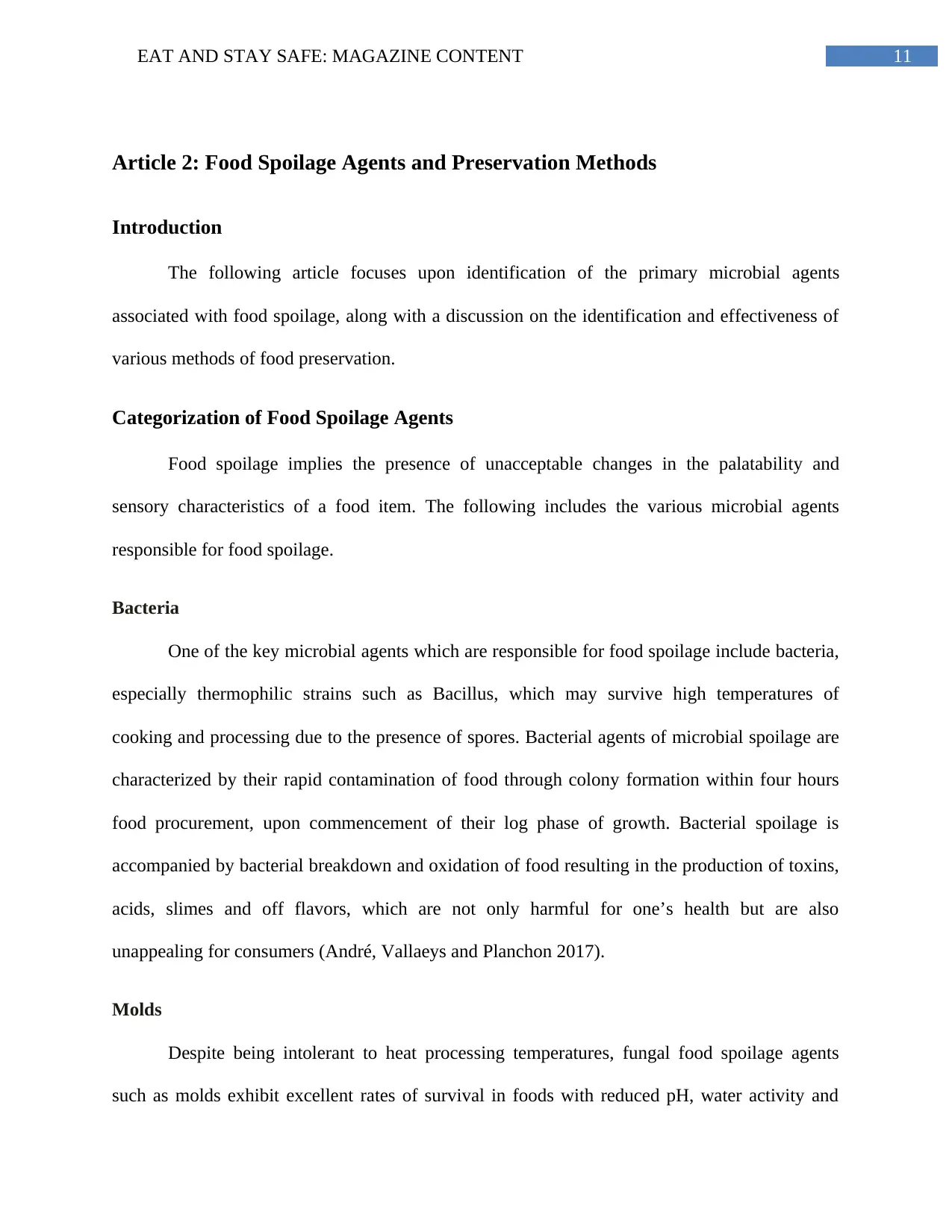
11EAT AND STAY SAFE: MAGAZINE CONTENT
Article 2: Food Spoilage Agents and Preservation Methods
Introduction
The following article focuses upon identification of the primary microbial agents
associated with food spoilage, along with a discussion on the identification and effectiveness of
various methods of food preservation.
Categorization of Food Spoilage Agents
Food spoilage implies the presence of unacceptable changes in the palatability and
sensory characteristics of a food item. The following includes the various microbial agents
responsible for food spoilage.
Bacteria
One of the key microbial agents which are responsible for food spoilage include bacteria,
especially thermophilic strains such as Bacillus, which may survive high temperatures of
cooking and processing due to the presence of spores. Bacterial agents of microbial spoilage are
characterized by their rapid contamination of food through colony formation within four hours
food procurement, upon commencement of their log phase of growth. Bacterial spoilage is
accompanied by bacterial breakdown and oxidation of food resulting in the production of toxins,
acids, slimes and off flavors, which are not only harmful for one’s health but are also
unappealing for consumers (André, Vallaeys and Planchon 2017).
Molds
Despite being intolerant to heat processing temperatures, fungal food spoilage agents
such as molds exhibit excellent rates of survival in foods with reduced pH, water activity and
Article 2: Food Spoilage Agents and Preservation Methods
Introduction
The following article focuses upon identification of the primary microbial agents
associated with food spoilage, along with a discussion on the identification and effectiveness of
various methods of food preservation.
Categorization of Food Spoilage Agents
Food spoilage implies the presence of unacceptable changes in the palatability and
sensory characteristics of a food item. The following includes the various microbial agents
responsible for food spoilage.
Bacteria
One of the key microbial agents which are responsible for food spoilage include bacteria,
especially thermophilic strains such as Bacillus, which may survive high temperatures of
cooking and processing due to the presence of spores. Bacterial agents of microbial spoilage are
characterized by their rapid contamination of food through colony formation within four hours
food procurement, upon commencement of their log phase of growth. Bacterial spoilage is
accompanied by bacterial breakdown and oxidation of food resulting in the production of toxins,
acids, slimes and off flavors, which are not only harmful for one’s health but are also
unappealing for consumers (André, Vallaeys and Planchon 2017).
Molds
Despite being intolerant to heat processing temperatures, fungal food spoilage agents
such as molds exhibit excellent rates of survival in foods with reduced pH, water activity and
⊘ This is a preview!⊘
Do you want full access?
Subscribe today to unlock all pages.

Trusted by 1+ million students worldwide
1 out of 29
Related Documents
Your All-in-One AI-Powered Toolkit for Academic Success.
+13062052269
info@desklib.com
Available 24*7 on WhatsApp / Email
![[object Object]](/_next/static/media/star-bottom.7253800d.svg)
Unlock your academic potential
Copyright © 2020–2025 A2Z Services. All Rights Reserved. Developed and managed by ZUCOL.





